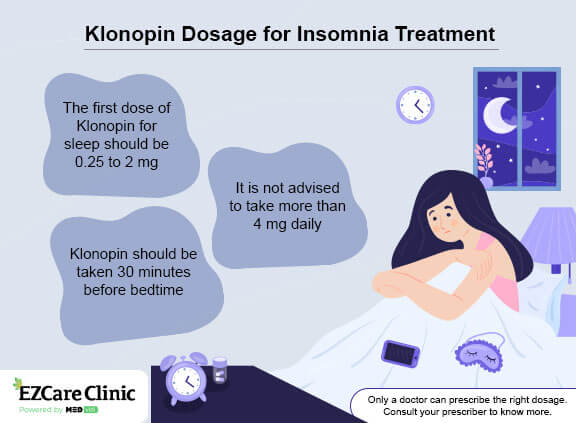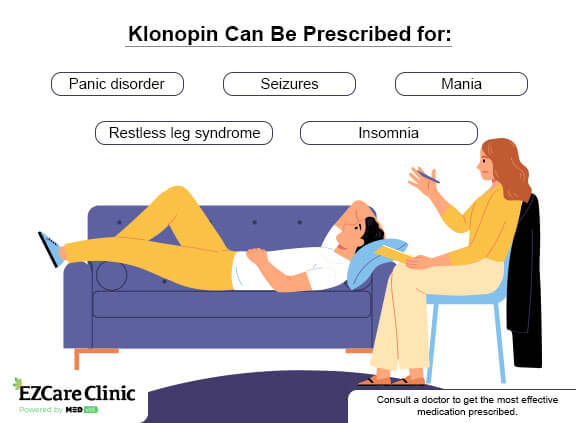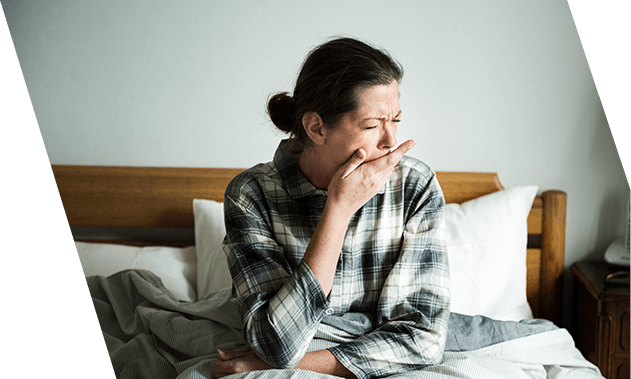The medications listed on this website are provided for informational purposes only. Their inclusion does not guarantee that they will be prescribed to any individual, as treatment decisions are ultimately at the discretion of healthcare providers. This list is not exhaustive, and healthcare providers may prescribe other medications, including non-stimulant options, based on the patient's unique health circumstances and needs.
Klonopin (clonazepam) relates to the class of benzodiazepines. It is FDA-approved for the treatment of panic disorder and seizures. Even though the FDA hasn’t officially approved Klonopin as a medication for insomnia, it is frequently prescribed for this purpose.
All this can make you want to learn more about this medication, how it works, and how to use it safely. Keep reading to get answers to vital questions like “is Clonazepam a sleeping pill?” and many others.
EZCare doctors ensure a personalized approach. Get suitable medications prescribed online.
Klonopin Uses
Klonopin is primarily used for treating different types of seizures, epilepsy, and panic disorders (conditions leading to panic attacks). Doctors can also prescribe the medication off-label. It means prescribing it as a treatment for other conditions that the drug is not officially approved to treat. For instance:
Restless leg syndrome [1*] - Mania (a state where the patient feels highly energetic, excitable, or irritable)
- Symptoms of alcohol withdrawal
Tardive dyskinesia [2*] - Insomnia
Is Klonopin a Sleeping Pill Initially?
Some
When Do Doctors Prescribe Klonopin for Sleep
Often, insomnia results from other underlying medical conditions, environmental changes, and traumatic events, and treatment involves solving the root cause. Klonopin is an excellent medication for individuals suffering from sleep disorders caused by anxiety and stress. These two conditions increase the heart rate and cause racing thoughts that make sleeping hard.
Various clinical trials have determined that using benzodiazepines by insomniacs could help them fall asleep quicker and stay asleep longer. However, researchers haven’t conducted enough research regarding

Doctors can use Klonopin to ease anxiety symptoms, helping some patients experience better sleep patterns and good-quality sleep if anxiety is the root cause of their insomnia. However, Klonopin’s benefits go past reducing anxiety and stress.
For instance, studies show that Klonopin is suitable for treating
Klonopin helps these people sleep better by increasing the neurotransmitters that have an inhibitory action on the central nervous system. It allows the body and mind to calm down and relax. These individuals experience lower anxiety levels and reduced risk of seizures and REM sleep disturbances. It also relieves RLS (restless leg syndrome), allowing users to sleep better.
Klonopin Dosage for Sleep
Doctors advise patients to start slow as low when choosing Clonazepam dosage for sleep. For instance, the first dosage of Klonopin for sleep should be between 0.25-2 mg, taken 30 minutes before bedtime. Physicians advise patients not to use more than 4 mg of the medication daily. Most insomniacs using clonazepam begin by taking a single low dose daily and slowly increasing the dosage as needed.
Individuals taking the medication should avoid alcohol. Additionally, they should avoid caffeinated foods and drinks, including soda, tea, chocolate, and coffee. Caffeine is a stimulant and will inhibit Klonopin’s calming effects.
The drug is available by prescription, and only medical professionals can prescribe and regulate proper dosages to make sure it fits the patient’s needs.
We are here to guide you along the way and adjust your treatment plan according to intermediate results.
Klonopin’s Side Effects
Klonopin users may experience these symptoms:
- Tiredness
- Blurry vision
- Muscle or joint pain
- Upper respiratory tract infections
- Drowsiness
- Depression
- Frequent urination
- Abdominal pain
- Feeling like you can’t remember or think as well as usual
- Problems with coordination or balance
Individuals who feel other severe side effects like facial or mouth swelling, rashes, hoarseness, or shortness of breath should immediately consult a licensed physician.
Some side effects may present themselves even until the following day. Clonazepam stays in the body for a long time, and the drowsiness symptoms may continue the day after.
For instance, patients may have difficulty thinking clearly, staying awake, performing tasks requiring motor function, and remembering things. The symptoms may impact your ability to operate machinery, drive, or experience normal functioning at work or school.

Can Klonopin Lead to Dependency?
Individuals can become dependent on Klonopin if they use it every day for prolonged periods and then discontinue it abruptly. Such individuals feel like their bodies don’t perform optimally unless they take the drug. That is why discontinuation should always be held gradually and guided by a medical professional.
The drug has addictive properties, and individuals who abuse it may require a detox to counteract their dependency.
Conclusion
Doctors may prescribe Klonopin for insomnia even though it is not FDA-approved for the treatment of this condition. It can only be prescribed and regulated by licensed medical professionals since it contains addictive properties, and various patients have different reactions to the drug. Consult with a medical professional to determine whether you require a prescription.
Sources
- Clonazepam and vibration in restless legs syndrome. (1984)
Source link - Clonazepam treatment of tardive dyskinesia: A practical GABAmimetic strategy. (1990)
Source link - Short-term cotherapy with clonazepam and fluoxetine: anxiety, sleep disturbance and core symptoms of depression. (2000)
Source link - Clonazepam: sleep laboratory study of efficacy and withdrawal. (1991)
Source link - Effects of long-term use of clonazepam on nonrapid eye movement sleep patterns in rapid eye movement sleep behavior disorder. (2013)
Source link
Expert help for mental health issues.
Get treatment from licensed healthcare professionals.







